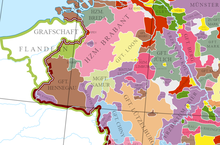County of Luxembourg
This article needs additional citations for verification. (April 2016) |
County of Luxembourg Grofschaft Lëtzebuerg ( Latin ) | |||||||||
|---|---|---|---|---|---|---|---|---|---|
| 1059–1353 | |||||||||
Feudal monarchy | |||||||||
| Count of Luxembourg | |||||||||
• 1059–1086 | Conrad I (first) | ||||||||
• 1346–1353 | Charles IV (last) | ||||||||
| Historical era | Middle Ages | ||||||||
• Obtained by Sigfried | 963 | ||||||||
• Acquired by House of Ardenne–Luxembourg | 1059 | ||||||||
• Raised to county | 1214 | ||||||||
• Raised to duchy by the Emperor | 1353 | ||||||||
• Held by the Dukes of Burgundy | 1443 | ||||||||
• To Habsburg | 1482 | ||||||||
• Occupied by France | 1795 | ||||||||
• Grand Duchy re-established | 1815 | ||||||||
| ISO 3166 code | LU | ||||||||
| |||||||||
| Today part of | |||||||||


The County of Luxembourg (
History
The historic region of Luxembourg was settled by
From the Early Middle Ages to the Renaissance, authors attributed different names to Luxembourg, such as: Lucilinburhuc, Lutzburg, Lützelburg, Luccelemburc, Lichtburg. The name is usually translated from the Latin as "little castle". However, modern historians believe that the etymology of the word Luxembourg is a derivation of the word Letze, meaning fortification,[citation needed] which might have referred to either the remains of a Roman watchtower or to a primitive refuge of the Early Middle Ages. The first known reference to the territory was by Julius Caesar in his Commentaries on the Gallic War.[2]
County
The ruined, supposedly Roman, fortification called Lucilinburhuc was first mentioned in 963, when Count
that provided prospects for trade and taxation. Although the history of Luxembourg began with the castle's construction, it seems that Siegfried and his immediate successors did not make the castle their primary residence.During the following years, a small town and market grew around the new castle. Its first inhabitants were probably servants of Count Siegfried and clergy of Saint Michael's Church. The settlement soon received additional protection by the construction of a partial
By 1060 the fortress had been extended by Siegfried's descendants.
In 1136 when Count
The town of Luxembourg became the centre of a state of strategic value in the
Elevation
The
Upon the extinction of the Luxembourg dynasty, the duchy passed to the
References
- ^ "Luxembourg | national capital, Luxembourg". Encyclopædia Britannica. Retrieved 27 October 2016.
- ^ "Luxembourg". Catholic Encyclopaedia. 1913. Retrieved 30 July 2006.
Further reading
- Ermesinde et l'affranchissement de la ville de Luxembourg; Etudes sur la femme, le pouvoir et la ville au XIIIe siècle, sous la direction de Michel Margue, Publications du Musée d'Histoire de la Ville de Luxembourg, Publications du CLUDEM tome 7, Luxembourg 1994
- Tatsachen aus der Geschichte des Luxemburger Landes, P. J. Müller, Luxemburg 1963, Verlag "de Frendeskres", Imprimerie Bourg-Bourger
- Vivre au Moyen Age: Luxembourg, Metz et Trèves; Etudes sur l'histoire et l'archéologie urbaines, sous la direction du Musée d'Histoire de la Ville de Luxembourg, Publications Scientifiques du Musée d'Histoire de la Ville de Luxembourg, tome 2, Luxembourg 1998
- About... The History of Luxembourg, Information and Press Service of the Government, Luxembourg 2022

